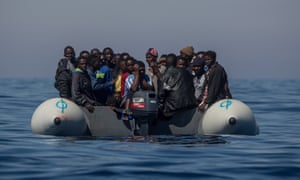
Only the wealthiest migrants and refugees could afford to pay for a voyage on the beautiful 10-metre yacht that sailed under a Ukrainian flag.
Today that sailboat is under police guard along with a dozen other luxury vessels impounded at the Sicilian port of Augusta. Its former skipper, Andrej, has recently been released from prison after serving a one-year sentence for aiding illegal immigration.
Andrej, 35, a Ukrainian, was convicted for transporting 30 migrants from Turkey to Sicily, landing on a small beach in the province of Syracuse. Each passenger paid more than €8,000 for the crossing.
Compared with the inflatable vessels and rickety fishing boats used to take migrants and refugees from north Africa across the Mediterranean, the mode of transport that Andrej offered – and others continue to offer – was exclusive and first class.
“I saw Syrian doctors, Afghan lawyers and magistrates, Iraqi professors and entrepreneurs [disembarking] from these boats,” said Carlo Parini, the police chief inspector for illegal immigration in the south-eastern port of Syracuse, who led the operations in which the boats were recovered from Turkey and impounded.
Some families are known to have paid nearly €100,000 to reach Europe from the Middle East. According to witnesses, some of those who arrived by yacht were dressed elegantly, carrying suitcases and expensive bags. After completing registration procedures on arrival, some went out for dinner at upmarket restaurants nearby.
Many of those who have arrived in Sicily by yacht from Turkey are fleeing brutal regimes and conflict, but they are able to pay for a level of safety – even comfort – that thousands of others cannot.
Police figures suggest 883 migrants landed inSicily by yacht between January and August this year. There were 682 similar arrivals in 2016.More than 120,000 people have arrived in Europe by sea so far this year, most having departed from Libya bound for Italy, from Turkey bound for Greece or, more recently, from Morocco bound for Spain, usually in shoddy, overcrowded vessels. The Italian route has proven to be the world’s most lethal.
Parini said these figures were estimates. “In reality, there are many more,” he said. “Some of these yachts head to other parts of Italy, such as Leuca, a town in the extreme southern tip of Apulia, close to Sicily. Some manage to disembark the migrants and go back. We cannot monitor every single sailing boat in the Mediterranean. It would be impossible.”
Italian authorities believe a Turkish crime ring with links to gangs in Ukraine is behind the luxury landings. The skippers ferrying the passengers on the impounded boats were exclusively Ukrainian and the vessels were registered in Turkey, the US or were rented.
Andrej said he left his country to look for work in Europe in order to escape national military service. “I needed to work and I had done a sailing boat course. When they asked me to bring these people to Italy, I accepted,” he told the Guardian, describing his bosses as Turkish. “Like [the passengers], I too had to flee from my country. But unlike them, I did not have the money to pay for yacht crossing. But I knew how to pilot it.”

Though controversial measures taken by the Italian government have led to a drop in the numbers of new arrivals in the past two months, hundreds of people continue to land in Sicily and southern Italy each week, according to authorities. Many are finding new routes and landing points to evade the tighter security measures.
Last June, the Guardia di Finanza (Italy’s finance police) in Palermo discovered a wave of clandestine journeys from Tunisia to Sicily using rapid boats capable of reaching the island in less than four hours, with passage costing €2,000-€3,000 per person. The traffickers were earning about €50,000 per journey. The police operation brought about the arrest of 15 Tunisian and Italian nationals.On the west coast of Sicily, large motorboats and motor-powered inflatables fly at high speed across the waters of the Mediterranean, carrying families of migrants and refugees from the ports of Tunisia to the provinces of Trapani and Agrigento. For their landings, they choose the most deserted beaches to avoid police controls.
At the beginning of the year, coastguard officers in Agrigento and Trapani stopped two rafted motorboats near the coast. On board were Tunisian families including a 12-year-old child. One of the speedboats was equipped with three 400-horsepower marine outboard motors, which are normally used for racing boats and are capable of pushing boats to speeds of up 90mph – faster than any vessel available to the coastguards.
“That sort of boat could reach Sicily from Tunisia in a few hours,” said Salvatore Vella, a prosecutor in Agrigento who has led some of the most significant investigations into people-smuggling in Sicily.
Vella said some people smugglers operated like “illegal travel agencies”. He said: “Like the legal ones, they offer first-, second- and third-class journeys. It depends how much money you can pay.”

No comments:
Post a Comment